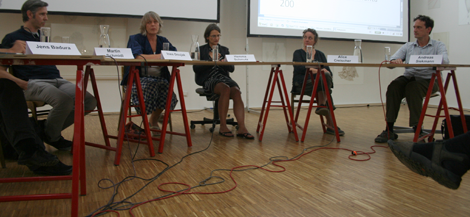| « How to construct an image – Lunch Talk Sonja Abian | The new, the old, and the phrases - Lunch Talk Marco Lulić » |
Artistic Reasearch – A discussion
A diverse group of artists, including Martin Schmidl, Ines Doujak, Alice Creischer and Adreas Siekmann, plus one „scientist“ to represent the other side, the philosopher and sociologist Jens Badura, came together last night to talk about something called artistic research. As introduction, moderator Hemma Schmutz asked the obvious question: What is artistic research? The artists began by each presenting a specific research project of their own. The start was made by Alice Creischer and Andreas Siekmann, who talked about their exhibition in Madrid titled „the Potosi principle“, where they brought never before seen colonial paintings out of bolivian churches into the Reina Sofia museum in Madrid and invited different artists to react to the painting.
The former mining city Potosi, exploited by colonialism, becomes linked to todays victims of globalisation. Funnily enough, Ines Doujak chose the same region for her project „ weaving shuttle and war path“. She and her team travelled to build up a textile archive that will be found on the outskirts of Vienna, funded by the austrian research fund, who initially were very confused about what she was actually doing. They collected textiles, books, and also interviews, learning about the deeper meaning and sacred knowledge stored in the pieces. Martin Schmidl, on the other hand, has an altogether different project. Intended as his PhD project in England, he was researching the history of exhibitions in the former concentration camp Dachau, as he was intrigued by it “being very similiar to normal exhibitions from the way everything is presented, but the approach to it is very different.“ In the end, his professors did not recognize it as art-related so Martin went to Vienna to finish it.
Then, Jens Badura shortly explored the relationship between arts and science and the meaning of the term defining the evening. „Artistic research is a term only coined recently and immediately seems to set it apart from other research“, he says. This might come from the archaic concept that research means proving some theory wrong, an idea that is still very prominent today. A different approach would be to call every scientist an artist, as they do creative work too. Here Andreas Siekmann begs to differ, as surely not every scientist, e.g. one working in an atomic reactor, can be called an artist. Also, he says, the artists often don’t use readymade systems, building their own structures and curating their own works, which stimulates the individual thinking process outside of structures, sometihng that is not encouraged in scientists. Ines Doujak also points out that the difference between artists and scientists lies in the thought, as „ reflecting about something gives you a lot more freedom than researching it.“ Asked about what tools they would like students to be given on their academic path, the debaters reached a consensus that the artistic education today seems to become more and more standardised, with no more room for individual thought and learning. Students don’t seem to organize themselves any more, they just go through the different classes as fast as possible, absorbing what they are taught. Martin Schmidl adds that he hopes artistic work won’t lose its spontaneity and adopt all the wrongs in scientific work. In the end, it seems like the fields are getting closer, morphing into each other, which makes the personal approach ever more important, the personal way of seeing and thinking that comes with time and experience, and which is something that will be researched as well, maybe with some results.



